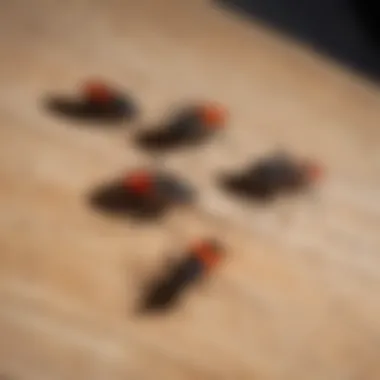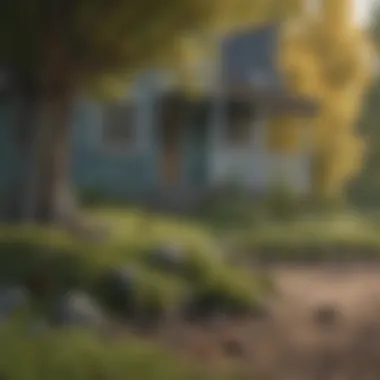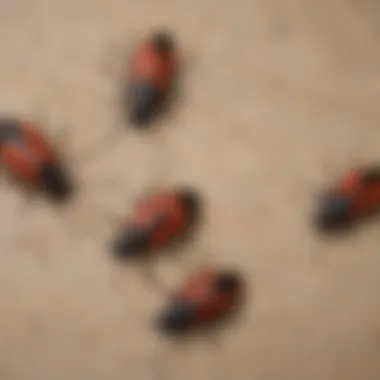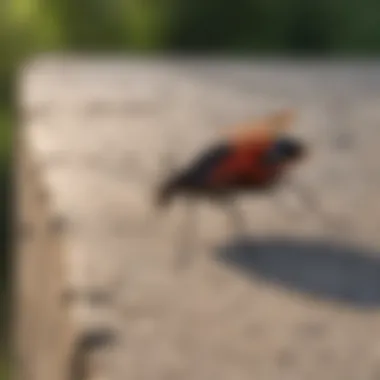Understanding Boxelder Bugs: Insights and Solutions


Intro
Boxelder bugs are small, black, and orange insects commonly found in North America. They attract attention, especially when they invade homes. Understanding their behavior and lifecycle is significant for effective management.
Their presence signals changes in the environment, affecting not just the pests but the ecosystems as well. This article will delve deep into boxelder bugs, their biology, why they prefer living near homes, and practical solutions for handling infestations. This way, homeowners can cultivate an informed approach for taking control of their living spaces.
Overview of the Topic
Prelude to the key natural resource or environmental issue being discussed
Boxelder bugs, scientifically known as Boisea trivittata, have gained scrutiny from homeowners due to the inconveniences they create. They often congregate in large numbers during the fall, searching for warm places to wait out the winter. While they do not pose direct threats to health, their invasion often interferes with daily life and can lead to concerns about long-term damage.
Background information on the significance of the topic
Understanding why boxelder bugs enter homes can shed light on broader environmental issues, such as climate change and urbanization. Identifying their food sources, which predominantly include boxelder and maple trees, reveals the impact that ecosystem management can have on pest control. Recognizing these connections allows homeowners to maintain their property's health while addressing an increasingly common nuisance effectively.
Current Status and Challenges
Examination of the current state of the natural resource or environmental concern
As climate conditions shift, boxelder populations may increase in areas once considered unsuitable for them. Particularly in urban environments, changes in landscape and warmer winters enable these bugs to thrive. This can transform the dynamics of local insect populations, creating a ripple effect throughout the ecosystem.
Identification of challenges and threats facing the topic
One primary challenge related to boxelder bug management involves the misunderstanding or lack of knowledge regarding non-lethal pest control methods. Furthermore, residents may resort to harmful or unsustainable solutions such as toxic pesticides, putting the environment and non-target species at risk. This highlights the need for education that embraces healthier, sustainable methods to deal with boxelder bugs.
Sustainable Solutions
Exploration of sustainable practices and solutions to address the issues highlighted
Developing a practical plan starts with understanding the lifecycle and preferences of boxelder bugs. Some steps homeowners can take include:
- Sealing cracks and crevices around windows and doors to prevent indoor access.
- Installing screens on vents to limit openings.
- Removing boxelder trees or managing surrounding vegetation thoughtfully to deter these pests.
- Utilizing natural repellents that minimize environmental impacts.
Showcase of successful case studies or examples of effective resource management
In a recent case study in Ohio, homeowners who actively managed vegetation around their properties reported a noticeable decrease in boxelder bug sightings. Implementing a collaborative strategy with local ecological councils resulted in improved understanding and practical applications for other pests too. Adopting such measures sustainably supports not just individual household goals but aligns with larger community efforts towards environmental harmony.
Impact and Importance
Analysis of the impact of the topic on ecosystems, communities, and future generations
Boxelder bugs serve as a reminder of how insect populations adapt to urban areas and changing climates. Their seasonal migrations and swarming behavior highlight challenges for local ecosystems and the risks to biodiversity when appropriate balance is not maintained. Understanding this dynamic helps communities prepare for future pest opportunities prompted by climate shifts.
Emphasis on the importance of conservation efforts and sustainable resource use
Working to control species like the boxelder bug integrates the need for pest management with broader conservation strategies. With educated decision-making and responsible practices, homeowners can ensure their actions contribute to overall ecosystem health rather than detract from it. Importance also lies in understanding our ecological responsibilities. каждым шагом можно создать лучшее будущее для всех.
Intro to Boxelder Bugs
Understanding boxelder bugs and their behaviors is essential for homeowners and environmental enthusiasts alike. As common intruders in our living spaces, knowledge of their characteristics and distribution can inform effective strategies for management and prevention. Not only does this understanding help in reducing living inconveniences caused by these insects, but it also enables individuals to make informed decisions regarding the use of ecological controls and interventions.


Characteristics of Boxelder Bugs
Boxelder bugs are distinguished by their black bodies with distinct orange or red markings. Their sharp silhouette and colorful appearance make them easy to identify. Common features include flat bodies, long antennae, and highly specialized wings that allow them to move swiftly. Typically, these insects grow to about half an inch in length.
The abdomen of the boxelder bug often reflects its feeding habits, particularly on boxelder trees. They are primarily herbivores, feeding on the sap of trees through sucking mouthparts. This can negatively affect tree health, although they seldom cause significant damage on their own.
Geographic Distribution
Boxelder bugs thrive in diverse ecosystems primarily across North America. They are often seen in areas with a dense presence of boxelder trees or similar species, favoring environments that provide warmth and suitable breeding conditions. Their range has expanded, adapted to various climates, reflecting their resilience and sociability. Prevalent in the United States and parts of Canada, their population density tends to spike in urban areas where food sources and shelter are plentiful.
The seasonal patterns that affect their behavior are often closely connected to temperature changes and available light. This adaptability contributes to their ubiquitous nature in homes, especially in the late summer and fall months when they seek warmth and shelter in buildings.
Understanding the characteristics and distribution of boxelder bugs is crucial for developing more strategic approaches for their management in residential environments.
Lifecycle of Boxelder Bugs
The lifecycle of boxelder bugs is crucial for homeowners to understand in effectively managing and preventing these pests. Grasping this concept helps provide a scientific foundation for individuals aiming to mitigate infestations in their spaces. Knowledge of the lifecycle enhances anticipation; one can act earlier and more decisively against potential outbreaks. Moreover, recognizing different stages can assist in applying appropriate interventions tailor-made for each phase of development.
Egg Stage
Boxelder bugs begin their lifecycle in the egg stage, which occurs during the spring. Females lay clusters of eggs, often numbering in the hundreds, on the bark of trees or in crevices of buildings. These eggs are small, usually about one millimeter in size, and tend to be a reddish or yellow hue.
The lifecycle initiates when temperatures reach appropriate levels, approximately between 70°F and 80°F, indicating favorable conditions for the hatching.
- Duration: The eggs can take roughly a week to hatch depending on the warmth and humidity.
- Visibility: Spotting them may require careful inspection, as they may be overshadowed by tree textures.
Understanding the egg stage makes it easier to reduce the potential dla explosion of ])er layers of prevention since intervention can begin before they hatch into more visible pest stages.
Nymph Stage
After the eggs hatch, boxelder bugs enter the nymph stage. This results in small, wingless insects that initially are European brown before gradually transitioning into their characteristic black-and-red coloration.
- Duration: The nymph stage usually lasts up to five to six weeks. It is during this period that nymphs feed aggressively on the plant mater. Monitoring during this phase is vital since they can rapidly multiply.
- Feeding Preference: They prefer feeding on box elder trees but may also be seen on maple or ash trees. The extent and severity of their feeding can impact the health of these plants.
Proper detction during this stage can lead to more successful prevention methods that address nymph density. Reducing their number here can limit famine in later stages.
Adult Stage
Once nymphs mature, they metamorphose into adults. Adult boxelder bugs are easy to identify due to their distinctive coloration, where they present as black with orange-red markings.
- Adaptation and Overwintering: These adults search for suitable overwintering sites as the cold months approach. This behavior can make attics and homes ripe for infestation. They can fit through tiny cracks and crevices, making their discovery a challenge.
- Reproductive Capacity: At this stage, they reproduce. Adult females can lay up to two generations of eggs in one season, making any increase in their numbers a point of concern.
Recognizing how adults behave provides insights into potential preventative strategies and the timing for interventions.
Understanding lifecycles aids greatly in informing more strategic approaches over time.
The Attraction to Homes
Understanding the reasons boxelder bugs are drawn to homes is critical for addressing potential infestations. Boxelder bugs, while often seen as a nuisance, have specific preferences that lead them to residential areas. Homeowners who grasp these causal elements are better equipped to develop strategies for minimizing these pests.
Environmental Preferences
Boxelder bugs thrive in environments that provide access to food and warmth. They are particularly drawn to boxelder trees, as their leaves and seeds serve as a primary food source. Furthermore, these insects favor areas that offer shelter from harsh weather, making attics, basements, and hidden crevices in wooden structures attractive.
Other environmental factors include sunlight absorption and dark crevices. In fall, boxelder bugs seek out warmer spaces to overwinter. Homeowners with older structures that exhibit gaps can inadvertently create hospitable conditions. This results in large populations if not addressed.


It is vital to conduct outdoor assessments. Identifying nearby boxelder trees and assessing the foliage capabilities encourages understanding of factors attracting this pest.
Seasonal Behavior Patterns
Boxelder bug behavior varies throughout the year. In spring, these pests emerge as temperatures rise, prompting them to migrate from private yards. In summer months, they become more active, reproducing and seeking to consume leaves of boxelder trees. The focus on reproduction during this period compels loose groups of bugs to be more likely noticeable around housing.
As fall approaches, matting behavior occurs. Groups can suddenly gather on sunlit surfaces seeking warmth. It's a prelude to winter hibernation, as they try to find the tiniest openings to enter homes. Meanwhile, during winter, boxelder bugs are typically inactive yet can pose a risk if nodded out during warmth emergence via overly warm climate heaters or drafts.
In summary, understanding boxelder bugs' environmental preferences and seasonal behaviors positively influences pest management. Homeowners can implement necessary preventive actions by becoming familiar with these patterns. Keeping trees trimmed and ensuring proper sealing of entry points are essential elements to sustain unwelcoming conditions for these pests.
Identifying Infestations
Identifying an infestation of boxelder bugs is crucial for homeowners and anyone interested in managing their presence within a living space. Recognizing the signs early can prevent larger-scale infestations, enabling effective interventions that limit their disruption. Additionally, acknowledging boxelder bug infestations may also contribute to a broader understanding of ecological balance within residential areas. Boxelder bugs, while often seen as a nuisance, are content providers of certain ecological roles. Detailed attention paid to their habits enhances communication about effective control measures among conservation enthusiasts and pest management professionals.
Signs of Infestation
Identifying the signs of a boxelder bug infestation starts with keen observational skills. Homeowners may notice clusters of bugs, especially as they seek warmth close to windows and doors. The first common indication is their presence multiplied in sunny areas just outside the home. This behavior typically occurs in late summer and early fall when adult bugs prepare for hibernation. Their distinctive black and orange coloration provides easy screening when in large numbers.
Several specific indicators can confirm an infestation:
- Presence of eggs, which are typically found on the bark of boxelder trees or nearby shrubs. They can appear as tiny colored spots.
- Molted exoskeletons indicating previous nymphs in the area. Understanding premature development cycles leads to apprehending the infestation dynamics.
- Physical signs, including stains from fecal matter, which can leave dark markings against surfaces. Noting these can distinguish between benign bugs and potentially harmful activity.
Overall, identifying these signs is the first ste of effective management.
Common Entry Points
Boxelder bugs find various common entry points as they invade homes, especially during cooler months. The first point of entry might surprise residents due to an unseen invasion of their spaces. Critical inspections to locate these entry strategies aid in establishing a barrier against re infestation.
The most frequent entry points include:
- Cracks and crevices in windowpanes: Low-quality seals create openings for boxelder bugs. Regular inspections ensure no wear compounds overall.
- Gaps in siding or eaves: These features can act like conduits, allowing these bugs easy access.
- Unprotected vents: Gaps around pipes or ducts provide opportunities for bugs. Homeowners should address physical interference promptly.
- Doors without screenings: Checking for tight seals and ensuring bug screens remain in proper condition is essential.
Overall, routine inspections of these areas following potential winters grappling around home can foster a protective strategy consistent with managing boxelder bug presence.
Health and Environmental Impact
Understanding the health and environmental impact of boxelder bugs is crucial for homeowners. Boxelder bugs are more than just an eye-sore; they can influence both human health and local ecosystems. This section enlightens on how these bugs affect our spaces as they invade homes and gardens.
Effects on Human Health
Boxelder bugs pose minimal direct threats to human health. They do not bite or sting, which makes them relatively harmless. However, their presence can contribute to allergens in the environment. Some individuals might experience unnecessary stress from infestations, leading to anxiety related to managing these pests.
One study indicated that high concentrations of insect secretions may induce respiratory issues in sensitive individuals. The bugs release a fould odor when crushed. This might result in discomfort and could occasionally trigger allergies for some people. Thus, maintaining a comfortable home environment becomes challenging when these insects invade. Regular cleaning and removal of smashed bugs from living spaces is required counter this.
Impact on Garden Ecosystems
While boxelder bugs typically feed on boxelder trees and similar foliage, their impact on broader garden ecosystems is noteworthy. Boxelder bugs might compete with beneficial insects for resources, inadvertently disrupting natural biodiversity. Their preference for certain plants can ultimately alter the natural interactions between various garden species.
Some unexpected consequences of their presence include:
- Reduction of beneficial insects: As the boxelder bugs consume resources, insects like ladybugs, which help control aphid populations, may be forced to disperse.
- Plant Health: Garden plants might become stressed if boxelder bugs are present in large numbers, leading to reduced growth and vitality.
- Disruption of Soil Composition: Plant feeding can attract other pests or pathogens, adding pressure on soil health.


Overall, even though boxelder bugs are not the most destructive pest found in gardens, their characteristics help to devise a larger context about how an unexpected nuisance can affect biodiversity and health.
The ecosystem is interconnected; thus, pest management should consider restoring balance rather than simply extermination.
Focusing on these implications encourages a more responsible approach to gardening and pest control practices. Thus increasing public awareness about boxelder bugs is essential not only for personal spaces but also for maintaining the broader health of ecosystems.
Preventive Measures
Preventive measures for boxelder bugs play a pivotal role in successfully managing these pests. Implementing such strategies not only reduces the likelihood of infestations but also mitigates the necessity for more drastic control methods later on. Effective prevention guarantees a harmonious living space, safeguarding both home and garden. By understanding the behaviors of boxelder bugs, homeowners can adapt their strategies accordingly, enhancing the effectiveness of the measures in place.
Home Maintenance Strategies
Environmental modifications and sound home maintenance can dramatically impact the presence of boxelder bugs. Simple changes in routine can lead to significant results. Pay attention to the following approaches:
- Sealing Cracks and Openings: Inspect your home thoroughly for cracks, gaps, and openings around windows, doors, siding, and foundations. Using caulk or weather stripping can shut entry points. Even small spaces are large enough for these bugs to slip inside.
- Regular Cleaning: Routine yard maintenance is essential. Clear away debris like fallen leaves, especially from the base of buildings, which can be attractions for boxelder bugs. Periodic vacuuming indoors will ensure that any bugs already in the home are quickly removed.
- Using Screens: Installing screens on windows and doors prevents these bugs from entering homes. Ensure that screens fit tightly, and repair any tear or damage promptly.
- Proper Ventilation: Ensure that your home has good ventilation. Boxelder bugs often seek shelter in dark and warm areas. Reducing these environments will make your home less appealing.
Implementing a combination of these strategies creates a robust line of defense against these pests.
Natural Deterrents
Creating a hostile environment for boxelder bugs can also be effectively achieved by relying on natural deterrents. These alternatives offer solutions that minimize harm to both humans and their surroundings. Key methods include:
- Essential Oils: Certain essential oils like peppermint, neem, and tea tree oil showcase repellant properties. Spraying diluted essential oil solutions on potential entry points can ward off boxelder bugs. Combine a few drops with water, and apply around areas such as window sills.
- Cider Vinegar: Homemade sprays containing cider vinegar can act as a deterrent. Mix equal parts vinegar and water in a spray bottle, which may deter boxelder bugs on contact.
- Diatomaceous Earth: This natural powder presents a less toxic option to voluntary household chemicals. Sprinkling diatomaceous earth around foundations creates an inhospitable surface for crawling insects.
- Cayenne Pepper: A blend of cayenne pepper and water can be an effective spray to deter boxelder bugs. Share it around flower beds and entryways to teach them to move elsewhere.
Utilizing these natural methods creates an environment less conducive to pests, ultimately fostering a more sustainable solution to the presence of boxelder bugs.
Effective Removal Methods
The presence of boxelder bugs in and around homes can be concerning for many homeowners. Understanding effective removal methods is crucial for safeguarding the living environment while minimizing disturbance to local ecosystems. Not only do these methods address the immediate issue of pest removal, but they also enhance overall home comfort. By employing the right measures, one can eliminate the bugs and prevent future invasions, fostering a more harmonious coexistence with nature.
Non-Chemical Solutions
Non-chemical solutions are often the first recommended strategies for eliminating boxelder bugs. These methods focus on physical removal and natural deterrents, avoiding reliance on harmful pesticides. Here are several effective approaches:
- Vacuuming: Using a vacuum cleaner is an immediate and efficient way to remove boxelder bugs within the home. It is vital to empty the vacuum bag or dispose of its contents outdoors to prevent re-infestation inside.
- Sealing Entry Points: Inspecting and sealing cracks or gaps in windows, doors, and siding will reduce the chances of boxelder bugs gaining access to the home. Materials like caulk or weather stripping can be used for effective sealing.
- Removing Attractants: Boxelder bugs often gather around specific types of vegetation, especially boxelder trees. If possible, consider trimming or removing these plants to dissuade bugs from settling nearby.
- Natural Repellents: Some homeowners find success with natural deterrents. Mixtures with vinegar or essential oils (like peppermint) can be sprayed at potential entry points as a repellent.
Implementing these non-chemical solutions can reduce boxelder bug populations drastically, eventually transitioning them away from your home.
Chemical Control Options
While non-chemical measures can be successful, some situations may require chemical solutions. Understanding the various products available and responsible use is crucial for effective control. Here are main types of options:
- Insecticidal Sprays: If infestations are severe, specific insecticidal sprays might be necessary. Pyrethroid-based products are popular choices for use on boxelder bugs, as they provide quick knockdown.
- Residual Insecticides: These products are applied around the perimeter of homes and can create a protective barrier. They allow for long-lasting effects compared to other sprays, meaning fewer reapplications are necessary.
- Diatomaceous Earth: This food-grade powder can be sprinkled in infested areas. It works by micro-abrasion; when insects come in contact with it, they suffer water loss and ultimately perish.
When considering chemical control options, it is vital to follow manufacturer instructions closely to ensure safe and efficient use. Applying these options sparingly and strategically can lead to better wildlife- and environmentally-friendly results.
When dealing with boxelder bugs, a balanced approach combining non-chemical and chemical solutions can yield the best results for effective pest management.
End
In this article, the importance of understanding boxelder bugs remains a prominent theme. Knowledge about these insects enables homeowners to address potential infestations effectively. As a common nuisance, boxelder bugs can disrupt one's peace and comfort at home. Providing effective insights into their lifecycle, behavior, and prevention strategies can greatly aid in managing their presence.
Summary of Insights
Throughout the discussion, various aspects of boxelder bugs have been analyzed. Insights include characteristics such as their distinct appearance and preferred habitats. Their lifecycle stages, ranging from egg to adult, clarify the urgency of vacuuming or removing early signs of infestation. Understanding their environmental preferences comes to the vanguard, as it emphasizes how they search for warmth during cold months. Sustaining a home environment requires measures that prevent entry through structural vulnerabilities. The comprehension of their behavior and various infliction strategies flips the paradigm from fear to informed response.
Final Thoughts on Management Strategies
When it comes to management strategies, effectiveness often hinges on a tailored approach. Homeowners should combine multiple prevention tactics. Regular maintenance can eliminate invitation to boxelder bugs year-round. Using natural deterrents, such as diatomaceous earth or essential oils, aligns with eco-friendly aspirations. Chemical control options should also be considered but ought to be a last resort. Homeowners can benefit greatly by evaluating the situation with a clear, calm perspective. An informed stance not merely discourages boxelder bug infiltrations; it gears one towards sustaining harmony within highly valued domestic spaces.



